

| Invertebrate news 2022 |
| Insect and Arachnid related news from around Nottinghamshire |
| Want your interesting or notable Nottinghamshire sightings listed? email trevorpendleton63@gmail.com |
|
Some new micro moths for VC56 Nottinghamshire 4.006 Stigmella sakhalinella Three mines found on a single Birch leaf at Warsop Main Pit Top, were intiallly thought to be the mines of Stigmella continuella, but on closer inspection were found to be Stigmella sakhalinella and a new species to Nottinghamshire. 4.082 Ectoedemia intimella (Zeller, 1848) New to Nottinghamshire in late October, when two occupied leaf mines were found on Goat Sallow Salix caprea, at Warsop Main Pit Top. 15.012 Caloptilia semifasciella (Haworth, 1828) Recorded new to the county as recently as October, when an individual was attracted to light at Keyworth (Pinder, N.). A second record of larval feeding cones found on Field Maple, quickly followed from Warsop Main Pit Top later the same month, so this moth has probably been overlooked in Nottinghamshire for a number of years. 15.087 Phyllonorycter comparella (Duponchel, [1843]) Recorded new to Nottinghamshire in October, when a number of both occupied and unoccupied leaf mines were found on Grey Poplar Populus x canescens, growing at Ollerton Pit Woods. This is another leaf miner of south-eastern counties of the UK, which seems to be spreading north over recent years. Likely to remain rather uncommon in Nottinghamshire on the basis of hostplant range. |
| ... |
|
A summary of some recent migrant moths recorded from Nottinghamshire It's safe to say, that for those trapping moths long enough to remember the great migrant year of 2006, that Nottinghamshire has experienced a great few weeks of migrant activity this late Summer and early Autumn, with a run of rare migrants coming on the back of favourable weather conditions during the course of the first week of September. |
||
| ... | ||
|
And when migrants reaching inland
counties such as Nottinghamshire, coincides with the continued range
expansions of Dark Crimson Underwing, Clifden Nonpareil, European
Corn-borer and Scrobipalpa ocellatella, then its an
exciting time to put the trap out. The following is a general summary of those migrant species recorded in the county, over August and September (to 20th). The species summaries include a general history of previous records/occurrences and those records from 2022, I am aware of. Most of the records are sourced from the Nottinghamshire Moths and Butterflies Facebook group, but a number have been communicated to me directly. Loxostege sticticalis (Linnaeus, 1761) 2022 saw an unprecidented number of records both nationally and locally to VC56 Nottinghamshire. Before this year, there were just three records from VC56, with this Pyralid very much being a huge rarity. At least four recorded at Broadholme since September 1st (Gray, M.), three from the Eakring area on September 2nd and 4th (Pendleton, T.A.) with further singles recorded at Tollerton (Watson, T.) on September 4th and Underwood on September 3rd (Hector Brown, K.) but there have doubtless been a number of other records. |
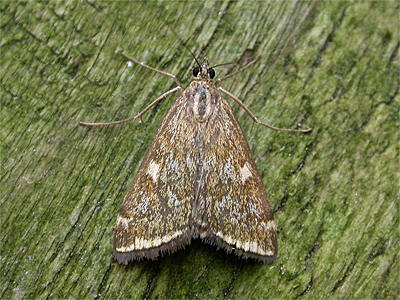 |
|
| ... | ||
|
Nomophila
noctuella Rush
Veneer Occurs on an
almost annual basis and is occasionally very common in
some years such as 2006 and 2015. Can often be disturbed
from vegetation during the day. There have been a number of
reports during September from Misterton, Eakring, Market Warsop,
Nuthall and East Bridgford. Agrius convolvuli Convolvulus Hawk-moth A rare migrant to Nottinghamshire, with scattered records across the south of the county. There were a total of five Nottinghamshire records in 2003, which was notable for the best ever influx of this moth into the UK. The most recent records prior to 2022 were from Ravenshead on August 20th 2020 and September 13th 2019 (McGeever, D. and McGeever, V.) and West Bridgford on September 12th 2015 (Hurst, A.). |
||
| ... | ||
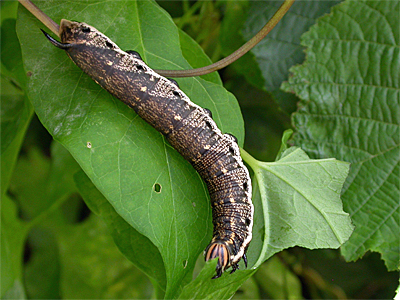 |
There have been several reports this year so far, inlcuding records
from Misterton on August 21st and September 3rd 2022
(both Lee, P), at East Bridgford September 5th and Caythorpe on
September 9th (both Reece, J.).
Records also include full-grown larvae found at Bulcote on September
5th (name not supplied) and September 7th
(Pendleton, T.A.) which may be the first larvae recorded in
Nottinghamshire? Macroglossum stellatarum Hummingbird Hawk-moth A regular migrant to Nottinghamshire and usually well recorded being a day-flying species. Numbers vary from year to year, but recent good years include 2006, 2011 and 2015. Numerous reports during 2022. September records include singles at Market Warsop on 07/09/22 (one of 37 I've recorded locally this year), two at Cotgrave on 13/09/22 (Demaine, L.) singles Rhodometra sacraria Vestal An uncommon migrant to Nottinghamshire, largely occurring here after occasional large influxes into southern parts of the UK. There were eight records from the county during the exceptional migrant year of 2006 and then a further five in 2013. Four individuals were recorded at Broadholme in 2006 (Gray, M.), but the same site has produced a number of other records in 2011, 2013 and 2014 (Gray, M.). |
|
| ... | ||
|
There are more recent records from West Bridgford in August 2012 (Freestone, R.), from Rampton (Watkin, C.) Sutton-in-Ashfield (Turton, J.) and Carlton in 2016 (Adcock, A.) and twice at the Idle Valley NR in October
2017 (Cadman, P. and
Hunt, I.). In 2022, singles have been reported on September 9th
(Gilbert, D.), singles from South Muskham on 13/09/22 and
16/09/22
(Kennewell, M.). Heliothis peltigera Bordered Straw An annual migrant to southern areas of the UK, but much rarer inland and far from being annual in the county. Last recorded in Nottinghamshire in 2015 when there were a total of seven records, but failed to turn up in the expected good numbers during the big migrant year of 2006, though there were three reports that year. One reported from Misterton on August 12th 2022 (Lee, P). Helicoverpa armigera Scarce Bordered Straw Normally an extremely rare migrant to Nottinghamshire, but following a huge influx into the UK in 2006, there were at least ten records. All but one of these occurred between September 6th and 23rd. Only recorded in the county since as a single record at Wellow Wood on October 4th 2013 (Wright, S. and Osborne, J.). One from South Muskham on 16/09/22 (Kennewell, M.). Mythimna albipuncta White-point A regular migrant to south-eastern parts of the UK and hascolonised some coastal areas. There are an increasing number of good claims of this moth in Nottinghamshire. However, it should be pointed out (and possibly rightly so) that some authorities are doubting the status of White-point as a distinct species on the basis of almost identical similarities within the genitalia of both Mythimna albipuncta and M. ferrago (Clay) and that albipunctata may indeed be a continental subspecies of ferrago. And it should be added, that many claimed White-points, look little different to Clay visually. A report of one at Misterton on July 29th 2022 (Lee, P). Peridroma saucia Pearly Underwing A relatively rare migrant inland with just five recent county records, although four of these have occurred since 2004. There are a number of records from Broadholme , which include moths on September 16th (2), 17th, 20th and 28th (2), with others on October 13th 2006 and October 1st 2014 (Gray, M.). One report in 2022 so far, from Kirkby-in-Ashfield on September 9th (Shaw, D.). Agrotis ipsilon Dark Sword-grass A regular and virtually annual migrant to Nottinghamshire, usually producing several records a year. Four recorded from Misterton (Lee, P.) so far in 2022. |
||
|
Phyllocnistis saligna (Zeller, 1839) found to be
widespread across north Nottinghamshire
Known from Nottinghamshire as recently as 2021, Phyllocnistis saligna has been found to be at all sites visited and checked for the moth between Retford and Sutton-in-Ashfield during September 2022. This is another leafminer which has been on the move northwards through the UK over the past few years. It was first recorded in Nottinghamshire by Steve Mathers in his garden at Stanton-on-the-wolds in September 2021 and recent surveys targetting the moth have proved it to be widespread and almost certainly county-wide by September 2022. Records have come from Ordsall, Budby, Kersall, Eakring Meadows, Wellow, Mansfield Woodhouse, Market Warsop and King's Mill Reservoir. The upper surface mines are easily found on the leaves of various narrow-leaved Salix sp, especially Crack Willow, with the larvae also mining the stems. |
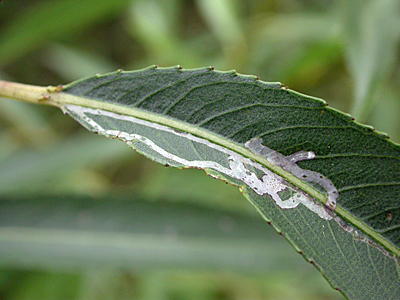 |
|
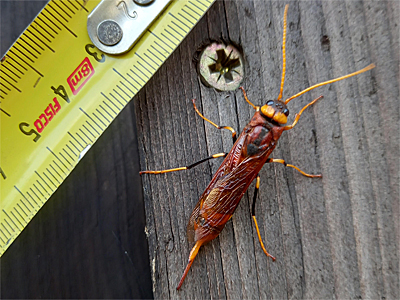 |
Possible first Nottinghamshire record of the Horntail Urocerus
augur This impressively large Horntail Sawfly, was reported by Stephanie Hancock from her Edwinstowe garden on August 21st 2022. It is likely to be a first record for Nottinghamshire. With only a handful of UK records listed on the NBN Atlas, the Sawflies (Symphyta) of Britain and Ireland website (sawflies.org.uk) says that 'Urocerus augur was introduced into Britain and Ireland. Now thought to be breeding in Britain after a female was observed ovipositing into Western Hemlock. Very similar to the common Urocerus gigas, but the yellow behind the eyes is more extensive and the hind tibia black in at least the apical half. In the female the ovipositor is longer being about as long as the forewing'. The larvae take two to three years to mature and live inside coniferous trees. Photograph courtesy of Stephanie Hancock. |
|
A second Nottinghamshire site for Dark Bush Cricket Known from just a single Nottinghamshire location since 2011, Dark Bush Cricket Phalidoptera griseoaptera (De Geer, 1773) has recently been recorded from the Nottinghamshire Wildlife Trust's Kirton Wood. The find, by Nick and Samantha Brownley, should mark the first of a number of new sites for this large Cricket, as it is firmly believed that it occurs elsewhere in Nottinghamshire. With no Nottinghamshire records for a number of years since the early 2000's, when Dark Bush Cricket had last been recorded from the Bingham Linear Park in 2003, it was reported by Louise and Alastair Gordon from field edges/ditches at Weston in the Trent Valley north of Newark in 2013, where it had apparently been present since at least 2011. It still remains in the Weston area, being recorded in good numbers (audibly) in August 2022. It is obviously more widespread in Nottinghamshire than thought and is suspected of being at a number of sites with suitable habitat along the Trent Valley. |
|
Dark Crimson Underwing finally recorded as new to VC56 Nottinghamshire Nottinghamshire's first record of this moth finally came at the end of July 2022, when Phil Lee took a single Dark Crimson Underwing Catacola sponsa (Linnaeus, 1767) at MV light in his Misterton garden. Based on the increase in records nationally over recent years (thought mostly to refer to migrants from the continent) this was always considered one of the most likely species to turn up in the county within the next few years. It had been increasingly recorded along south-east coasts, but there were records from south Midland counties, hinting that one was very much on the cards for Nottinghamshire soon. And so it proved, as after Phil's Misterton first on July 28th\, there soon came second and third records from an area of private woodland in the south of the county (Dulwich, P.) on August 13th and at Market Warsop on August 15th (Morton, D.). Many thanks to Dave Morton for very kindly providing the moth illustrated here. |
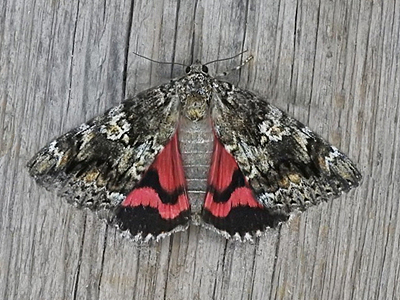 |
|
|
..... and a new micro too Martin Gray recently added the micro Depressaria pulcherrimella new to the Nottinghamshire list in late July 2022, when attracted to light at his Broadholme garden. Broadholme lies on the Nottinghamshire/Lincolnshire border, but is in VC56 Nottinghamshire. Depressaria pulcherrimella is described as being somewhat local across southern counties, but having foodplants such as Wild Carrot and Burnet Saxifrage, this moth could well turn up at some of our former colliery sites. |
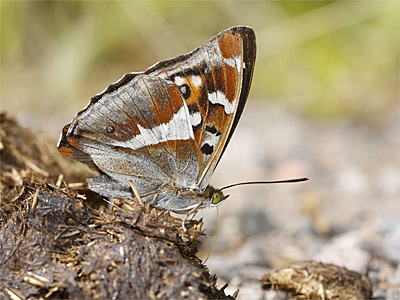 |
The latest on Sherwood's 'big three' lepidoptera and a new butterfly
for the Sherwood Forest NNR It's been an exciting few weeks recording lepidoptera in the woods and former Pine plantations making up the Sherwood Forest area. The big news is that after the rediscovery of the Purple Emperor at Sherwood in 2020 by Nick and Samantha Brownley, another two butterflies have appeared at sites comprising parts of the NNR and both have been recorded egglaying - thus confirming the first definite breeding of both species here. One of those new species - Dingy Skipper Erynnis tages (Linnaeus, 1758) has been on the cards to appear in suitable habitat at Sherwood for a number of years, even despite the fact that there has always been very little suitable Dingy Skipper habitat here and much of what there was along the outskirts of Budby South Forest, has been totally destroyed by contractors involved with the removal of contaminated soil. So it was pleasing when Dingy Skipper was found along a forest track running between Clipstone Old Quarter and Blackpool Plantation in June (Brownley, N. and Brownley, S.) and egglaying was later proven. |
|
| Purple Emperor photo, by kind permission of Nick and Samantha Brownley | ||
| .... | ||
| Sherwood's other new arrival, or rather first record in over a century concerns Silver-washed Fritillary Argynnis paphia (Linnaeus, 1758), which was initially recorded in the Hangar Hill Plantation area by Nick and Samantha Brownley. At first it was suspected that a few sightings relatively close together, involved just one widely roaming individual, but observations relayed by texts between several observers (Nick and Samantha Brownley, Simon Roberts, Indy Kiemel Greene and Trevor Pendleton) across a very large area of the forest, brilliantly showed how cooperation between a number of observers on site can pay dividends. And in the long run, it allowed the collation of all sightings on subsequent dates to produce an accurate map of Silver-washed Fritillary sightings across the forest over the next few weeks. | ||
| .... | ||
|
In recent years there
has been an increasing number of
Silver-washed Fritillary
records from across Nottinghamshire. That includes known releases of
captive bred stock at both Dyscarr Wood and Cotgrave Forest in
addition to those at Eaton and Gamston Woods and probably at several
other additional sites and news of the butterfly at Sherwood Forest,
once again prompted immediate calls from some quarters of 'release'.
But the number of isolated records from across the county in the years running up to 2017, suggests that the butterfly has been undertaking a range expansion and attempting to recolonise Nottinghamshire. Ultimately, mapping the sightings (right) gave a really good picture of the year's Silver-washed Fritillary records and when a female was filmed egglaying in Sherwood Forest for the first time in over a century, it seemed to make all those hours spent in the field worthwhile. |
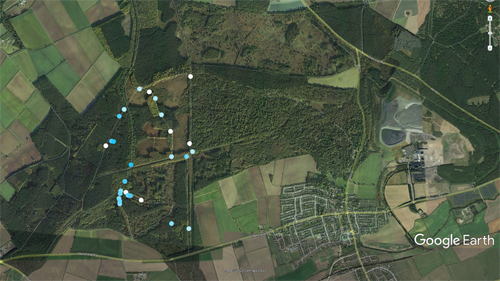 |
|
| The recording of Silver-washed Fritillary's was initially a by-product of surveying for Purple Emperors at Sherwood Forest. Once again, it has been the tireless work of Nick and Samantha Brownley who have done the leg-work and put in countless hours. But those hours have provided yet more useful information on the range of Purple Emperor across the Sherwood Forest area. |
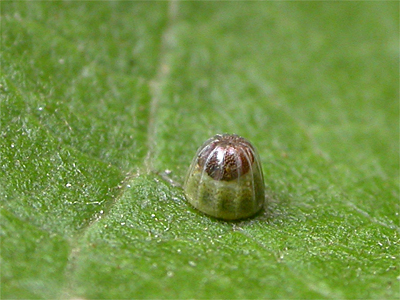 |
Surveying has revealed
that the butterfly has a far wider range at Sherwood Forest than had
been recorded during the flight period of 2021 and although a number
of adults were seen at some of the same locations as last year,
there were a number of locations well away from these. Searches for
eggs also showed that females range much more widely than males and
these are usually seen flying at much lower height, often
flying
very fast, three or four feet above forest tracks and paths. Once again, most Goat Sallows on which eggs, larvae and pupae were found in 2021, have provided eggs again in 2022, with the first eggs found by Nick and Samantha on July 17th. But the very hot and extremely dry weather experienced at the time, has unfortunately meant that some eggs have failed, with the larvae seemingly dying in the egg just prior to hatching (left). Without a doubt, the cause has to be the unusually high temperatures of near 40°C, but being well above that for those eggs sat in direct sun for at least part of the day. In all, over 30 Purple Emperor eggs have so far been located by Nick and Samantha by July 26th and news on the fate of these will come in time. |
|
| And lastly, in this brief round up of Sherwood Forest's 'big three' is news of a very successful season for Broad-bordered Bee Hawk-moth Hemaris fuciformis Linnaeus, 1758) which continues its local range expansion apace. Once again, a great deal of man hours was put into surveying this moth by looking for eggs and then the characteristic larval feeding damage. It produced some remarkable results, once again based on the efforts of Nick and Samantha Brownley and myself, we were able to show that Broad-bordered Bee Hawk-moth is widespread across the Sherwood Forest NNR and Clumber Park areas, but it was also recorded from Wellow Park for the first time. It proved t be a very easy species to find. | ||
|
Hedychridium ardens at Budby South Forest This tiny Chrysid Wasp is a very recent addition to the Nottinghamshire fauna, after first being recorded during an invertebrate survey by Tim Sexton. It was found on the site of the former Rufford Colliery at Rainworth by Tim in June 2020 and it has just been recorded for the first time within the Sherwood Forest NNR, at Budby South Forest in July 2022 (Pendleton, T.A.) when an individual was found sat on Bramble flowers. As with most Chrysid wasps, safe identification can only be achieved by close examination of a specimen. Hedychridium ardens has several host species which it uses, including Cerceris arenaria and Cerceris rybyensis, which are the most likely two species to be used in Nottinghamshire. Hymenoptera has continued to be poorly recorded in Nottinghamshire for many years and the potential for new county additions is great, especially with many species moving north as conditions become more suitable. There's a whole new study for someone with an interest in such a neglected order. |
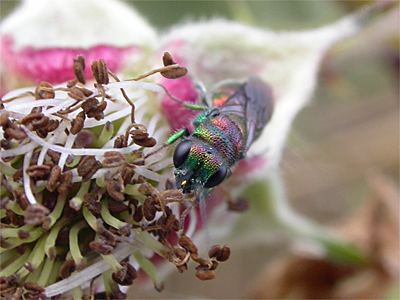 |
|
|
Hummingbird Hawk-moths arrive in numbers The third week of June has seen some very warm weather suitable for moth migration from the continent and its been the Hummingbird Hawk-moth which has turned up and it looks set to be a bumper year. I've had a number of records including singles nectaring at Valerian at Day Street, Market Warsop on 19/06/22, 25/06/22 and 26/06/22, with three within a brief ten minute spell there around 08:45h on 24/06/22. This included two together at one point and another identifiable as different through wear to the abdomen. One was recorded flying due north past me at Clumber Park on 20/06/22, two were nectaring on Valerian and also Viper's Bugloss on wasteground between Church Street and Burns Lane in Market Warsop, but the strangest record was of two flying inches above a bare, woodland access track in Wellow Park on 25/06/22. The moths repeatedly flew back and forth within a few inches of the ground and occasionally interacted, but never settled or paused to nectar from flowers. |
|
Some new lepidoptera for the Sherwood Forest NNR? Nick and Samantha Brownley have spent many hours recording in the Sherwood Forest area and have reported that Six-belted Clearwing is now present in the NNR. As far as is aware, it's the first record of this day-flying moth anywhere within the reserve. Several Six-belted Clearwing Bembecia ichneumoniformis ([Denis & Schiffermüller], 1775) have been found along a flower-rich track running between Clipstone Old Quarter and Blackpool Plantation and the moth is known to have bred with larval damage/feeding signs on Bird's-foot Trefoil noted. Also potentially new to Sherwood, is Dingy Skipper Erynnis tages (Linnaeus, 1758), which was first found in the same area by Nick and Samantha during May. |
||
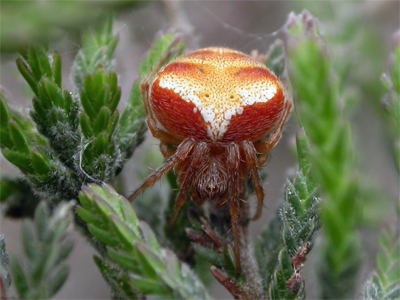 |
The spider Araneus triguttatus found new to Nottinghamshire A brief visit to Budby South Forest to film the weevil Attelabus nitens, turned out to be quite worthwhile with the chance discovery of the spider Araneus triguttatus (Fabricius, 1775) on Heather. With a UK distribution across south-eastern counties, roughly lying south of a line from The Wash to the Severn Estuary, there are a few records from counties just north of this line. Araneus triguattatus perhaps should have been expected and with hidsight it is perhaps surprising that it has not been recorded from VC56 Nottinghamshire before. The Budby find of an individual sat at the top of Heather on June 1st 2022, was also surprising as A. triguttatus is more a spider of deciduous woodland, often building its orb web on Oak. |
|
| The record also means second new species for the Sherwood Forest NNR, following on from the recent addition of Maro minutus O.P.-Cambridge, 1906, by members of the British Arachnological Survey (BAS) in 2021. | ||
|
Two new beetles for Sherwood Forest NNR Despite very little active recording this year, I came across the Tortoise Beetle Cassida vibex (Linnaeus, 1767) on Burdock Arctium lappa at Clipstone Old Quarter on 16/05/22, adding it to the Sherwood Forest list. Nottinghamshire records of Cassida vibex have increased in recent years Nottinghamshire records of Cassida vibex have showed an increase in recent years, occurring at a number of widely spaced localities including Market Warsop, Oakham LNR (Mansfield), Bingham Linear Park, Wilford, Gedling and Toton. Sherwood Forest's other recent addition is the Jewel Beetle Agrilus sulcicollis found by Adrian Dutton on June 2nd 2022. A. sulcicollis is found on Oak and had been on the cards as a likely Nottinghamshire addition for a few years. |
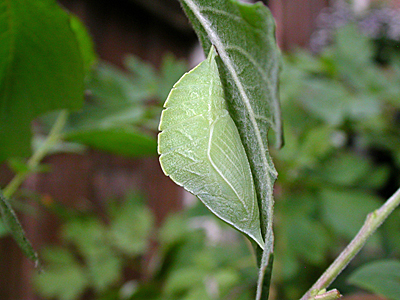 |
Purple Emperor doing well in Sherwood Forest 40 or 50 years ago, the Purple Emperor breeding in Nottinghamshire was completely a thing of childhood dreams. I know, because I was the one dreaming it. But decades on and that dream is now reality and within the famous Sherwood Forest, the Purple Emperor is doing surprisingly well and proof of that is entirely down to the work of Nick and Samantha Brownley. Nick and Samantha's meticulous surveys, observations and recording of the butterfly in all its stages (from eggs to adults) throughout the seasons is quite remarkable and they have detailed the locations of many larvae over the Winter and Spring. In recent weeks, it has been found that the Purple Emperor has a wider range at Sherwood Forest, than previously thought and larvae have been found in Clipstone Old Quarter for the first time. A total of five larvae have been recorded and Nick and Samantha's survey work continues as Sherwood Forest's larvae feed up before entering the early stages of what is a lengthy pupation process. |
|
|
Oil Beetles again at Newstead Abbey
After a gap of over five years, there is positive news that the Oil Beetle Meloe proscarabaeus (Linnaeus, 1758) is still present at Newstead Abbey. Formerly found in the cricket pitch and car park areas, it seems that despite the huge footfall, the beetle has managed to survive. There had been no reported Newstead records since David and Veronica McGeever reported them as long ago as March 2016, so when David Shaw visited Newstead Abbey on April 11th 2022, it was great to see that they have somehow managed to survive despite the heavy footfall and traffic in the area. David found two live Oil Beetles, but did record at least one dead. It's amazing that they have survived there at all. |
|
Dotted Chestnut and White-marked in Nottinghamshire again Martin Gray added Dotted Chestnut Conistra rubiginea ([Denis & Schiffermüller], 1775) to his increasing Broadholme garden list recently, when two individuals were trapped overnight on March 24th 2022 and there's news of another at Eaton Wood near Retford two days prior. Dotted Chestnut remains very rare in Nottinghamshire, with just a single modern record of one to Steve Mather's Stanton-on-the-Wolds garden Blacklight on November 3rd 2019. But one trapped at Eaton Wood near Retford by Colin Watkin on March 22/03/22 and the two trapped in Martin's Broadholme garden on 24/03/22, are strong evidence that this moth is now increasing both here in Nottinghamshire and elsewhere in the UK. It looks likely that this species is set to become more regular in the next few years? And there is another Spring moth that is either increasing or having a relatively successful time and that is White-marked Cerastis leucographa ([Denis & Schiffermüller], 1775). On the same night as his Dotted Chestnut, Colin Watkin also trapped a White-marked at Eaton Wood, which is the first in the county since Colin recorded one in his garden at Rampton on 05/04/19. |
||
|
Pheremone lure changes the known distribution of the Tortrix
Pammene giganteana in Nottinghamshire Since 2011, this early flying Tortix was known from just a single county record, of one attracted to light from the Sherwood Forest CP in 2011. Despite numerous other trapping sessions in the Sherwood Forest area, Pammene giganteana (Peyerimhoff, 1863) was never recorded again and its status as a real Nottinghamshire rarity seemed set. However, the use of several pheremone lures (namely the SUS and SKI lures) have showed this moth to be widespread and common. 2022 records have all been to pheremone lure, but the pale hind wings make it quite obvious when seen in flight. Several Pammene giganteana being recorded by Samantha Batty at Sherwood Forest CP in early March and my own work with the SKI lure, found the moth found present throughout the Country Park and Clipstone Old Quarter areas and at sites as far apart as Spalford Warren, Lound Wood (Eakring), Peafield Lane (Mansfield Woodhouse), Theives Wood and Harlow Wood south of Mansfield. Male moths react very quickly to the SKI lure, usually appearing within one or two minutes. |
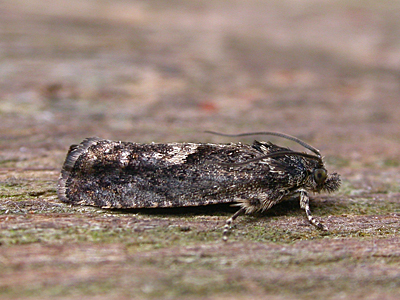 |
|
| ..... | ||
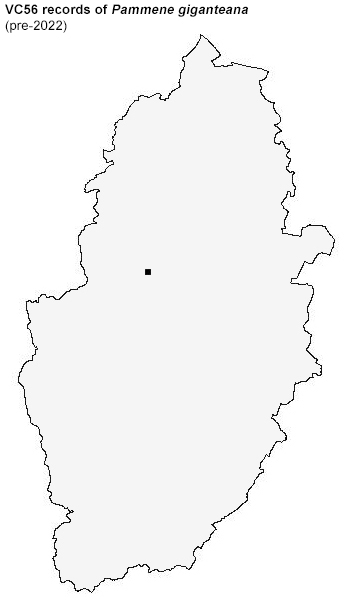 |
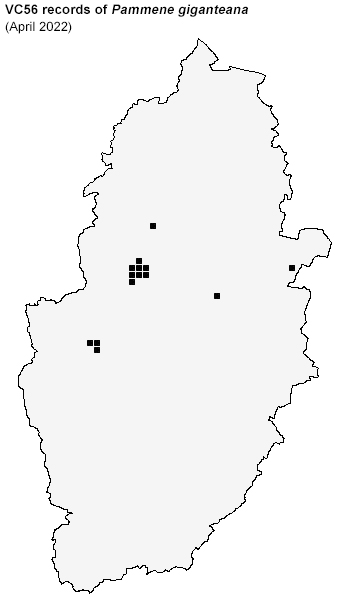 |
|
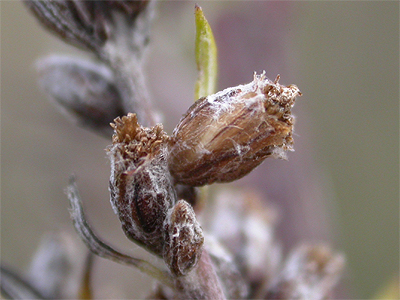 |
Coleophora artemisicolella - second
Nottinghamshire
record and a new moth for the Sherwood Forest
NNR It's taken nearly a decade to find another, but larval cases of Coleophora artemisicolella (Braund, 1855) were recorded from Clipstone Old Quarter in February 2022. Not only is the record the second for Nottinghamshire, but the first for the Sherwood Forest NNR. Coleophora artemisicolella is probably widespread over much of Nottinghamshire, being found where the larval foodplant Mugwort Artemesia vulgaris is found. Yet it seems there are still just two county records following the first for Nottinghamshire being found at Church Warsop in October 2013. The larval case (made from an empty seedhead) is certainly one of the most difficult of all the Coleophora cases to locate. |
|
|
New to Nottinghamshire, those moths recorded new to VC56 in 2021 2021 ended up being quite an exceptional year for additions to the county moth list, which includes the following list of species. There were probably eleven micro moths and two macro moths recorded new, with the county micro moth recorder believing that Micropterix aureatella is new, although there is a record listed somewhere. The following list of moths were recorded for the first time in Nottinghamshire. Apologies, if any others that may have occurred are not listed below. Micropterigidae: 1.003 Micropterix aureatella Nepticulidae: 4.012 Stigmella aceris Psychidae: 11.007 Bankesia conspurcatella (Cadman, P.) Tineidae: 12.031 Tinea columbariella Gracillariidae: 15.002 Caloptilia cuculipennella and 15.0931 Phyllocnistis citrella Cosmopterigidae: 34.005 Cosmopterix zieglerellana Pterophoridae: Hellinsia lienigianus Mugwort Plume (Coombes, P.) Torticidae: 43.343 Cydia amplana (Gray, M.), 49.346 Grapholita lobarzewskii (Beeley, G.) and 49.364 Pammene suspectana (Batty, S.) Geometridae: 70.145 Pasiphila debiliata Bilberry Pug Erebidae: 72.060 Hypenodes humidalis Marsh Oblique-barred |
||
|
First Nottinghamshire record of Small Brindled Beauty for over a
decade On a mild February 2nd, I ran a 125W MV light for nearly two hours at the Sherwood Forest Counry Park. Among the typically expected species, was a Small Brindled Beauty Apocheima hispidaria ([Denis & Schiffermüller], 1775) which not only represented a new (and rare) species personally, but was also the first for the county since a record from 2010, which doesn't seem to have ever made it to the county recorder. Small Brindled Beauty is rare in Nottinghamshire, where it is restricted to the Buck Gates/Country Park area of the Sherwood Forest NNR. There have been four post-2000 records - from 2002 (Wright, S. and Osbourne, J.), 2004 (Wright, S. and Osbourne, J.), 2005 (Wright, S. Osbourne, J. Fox, D. and Saunders, P.) and what seems to be an unsubmitted record from 2010 (Dawson, M. and Beasley, N.). |
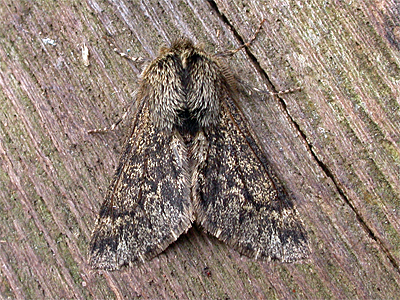 |
|
| Insects |
| Homepage |